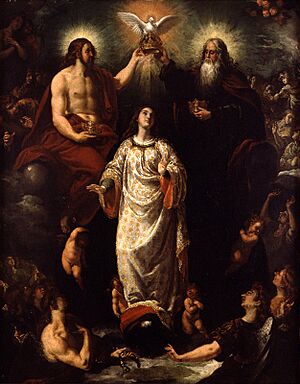Vicente Castelló facts for kids

Vicente Castelló (born around 1585 in Valencia, Spain – died 1636 in Valencia) was a Spanish painter. He painted in the Baroque style, which was popular during his time.
Vicente was the son-in-law of a famous painter named Francisco Ribalta. His painting style was very similar to Ribalta's. He also painted like his brother-in-law, Juan Ribalta. Because their styles were so alike, many of Castelló's paintings were mistakenly thought to be by the Ribaltas. People almost forgot about Castelló until these mistakes were corrected much later.
Contents
Early Life and Training
Vicente's father, Salvador, was also a painter. He came from Aragón to Valencia just before Vicente was born. Vicente's mother, Jerónima Comes, was the daughter of another painter, Jerónimo Comes. It is likely that Vicente's father worked with Francisco Ribalta for some time. This connection probably helped Vicente learn about painting.
In 1616, Vicente Castelló officially joined the College of Painters. This was an important step for artists in those days.
Working with Other Artists
After 1620, Castelló started working in Segorbe. He often worked with Juan Ribalta and another artist named Abdón Castañeda.
Together, these three artists created a large altarpiece in Andilla. They finished this important work in 1626. They also painted two pictures for a chapel in the Segorbe Cathedral. Sadly, these two paintings are now lost.
One of Castelló's paintings, Apotheosis of San Bruno, was first thought to be by Francisco Ribalta. It is now at the Museo de Bellas Artes de Castellón. Experts now believe Castelló painted it. He also finished the Virgin of Porta-Coeli painting. Francisco Ribalta had started this work in 1625. It is now displayed at the Museo de Bellas Artes de Valencia.
Taking Over the Workshop
Both Francisco and Juan Ribalta died in 1628. After their deaths, Vicente Castelló took over their family painting workshop. This meant he was in charge of their art business.
In 1630, Castelló was back in Segorbe. He took part in a painting challenge with another artist, Pedro García Ferrer. They had to create a painting about the Story of the Innocents. The rule was that they could not copy anything from other artists. The loser of the challenge would have to pay fifty Libras, which was a lot of money back then!
The last time we hear about Castelló is in 1635. This was from the papers of the Bishop of Segorbe, Pedro Ginés de Casanova. The papers mention a painting Castelló was asked to create, showing The Last Supper.
Castelló's Unique Style
For a long time, it was hard to tell Castelló's paintings apart from the Ribaltas'. But now, art experts can spot his unique style.
- He often used exaggerated foreshortening. This is a painting technique that makes objects or figures look shorter and closer than they are. Castelló used it to make his figures look longer.
- His brushstrokes were not as precise as the Ribaltas'.
- He used darker colors for the backgrounds in his paintings.
These special features have helped experts identify Castelló's own works. They have also helped separate his paintings from some that were once thought to be by Pedro de Orrente.
See also
In Spanish: Vicente Castelló para niños


